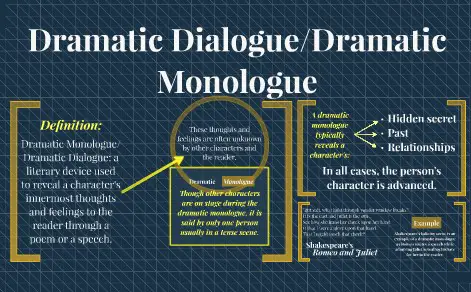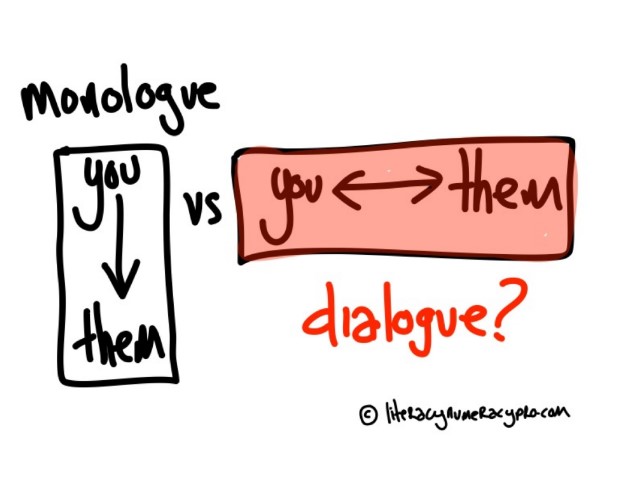Communication forms the backbone of storytelling, whether it’s unfolding on the pages of a novel or coming to life on the stage. The way characters express themselves, either through monologue or dialogue, is pivotal in developing the narrative and revealing their inner workings. Each method has its own nuances and applications, shaping the way stories are told and received.
Monologue and dialogue stand as two fundamental aspects of narrative and performance arts, each serving unique purposes. A monologue is a speech delivered by a single character, offering a deep dive into their thoughts, feelings, or backstory. Dialogue, on the other hand, involves an exchange of words between two or more characters, driving the story forward through interaction. These forms of expression provide distinct ways for characters to connect with the audience and each other.
Understanding the difference between monologue and dialogue is crucial for anyone interested in literature, theater, or film. Monologues often allow for a detailed exploration of a character’s psyche, while dialogues create dynamic relationships and plot progression. Both are essential tools in a storyteller’s arsenal, used to engage the audience, develop characters, and weave compelling narratives.

Monologue Defined
Definition and Characteristics
A monologue is a speech or verbal presentation that one character gives to express their thoughts aloud or directly address the audience, other characters, or themselves. This method is a powerful tool in both literature and performing arts, allowing for deep character exploration and plot development. Monologues are distinguished by several key characteristics:
- Length: They can vary significantly in length, from a short soliloquy to a lengthy speech.
- Focus: The focus remains on a single speaker’s perspective, offering a unilateral viewpoint.
- Purpose: Monologues often serve to reveal a character’s deepest thoughts, feelings, or plans, providing insight into their motivations and internal conflicts.
Types of Monologues
Monologues come in various forms, each serving a different purpose in storytelling:
- Soliloquy: A character speaks to themselves, revealing their thoughts when alone. These are common in plays, offering insight into the character’s inner world.
- Dramatic Monologue: Often found in poetry and drama, where a speaker addresses a silent listener, revealing aspects of their character in the process.
- Interior Monologue: Represents the character’s thoughts running inside their head, often used in novels and short stories to present a stream of consciousness.
Uses in Various Mediums
Monologues are versatile and find their place across multiple mediums:
- Theater: Used to build tension, reveal character motives, or provide background information.
- Film and Television: Often utilized in key scenes for dramatic effect or character development.
- Literature: Helps in deepening the reader’s understanding of the character or the storyline.
Dialogue Defined
Definition and Characteristics
Dialogue is a written or spoken conversational exchange between two or more characters. Unlike monologues, dialogues are dynamic and reflect the interplay of different viewpoints, making them essential for character development and plot advancement. Characteristics of dialogue include:
- Interactivity: Dialogues are interactive, involving multiple participants in the conversation.
- Purpose: They serve to reveal relationships between characters, advance the storyline, and inject realism into the narrative.
- Variability: The tone, style, and content of dialogues vary widely depending on the context and the characters involved.
The Role of Dialogue in Storytelling
Dialogue plays a crucial role in storytelling, with several key functions:
- Character Differentiation: Dialogue helps distinguish characters from one another through their speech patterns, dialects, and word choices.
- Plot Progression: Conversations between characters can introduce new plot points, conflicts, or resolutions.
- Realism and Engagement: Realistic dialogue enhances the believability of the story and keeps the audience engaged by mimicking real-life interactions.
Variations of Dialogue
Dialogue can take many forms, each adding a unique layer to the narrative:
- Direct Dialogue: The actual words spoken by characters, often enclosed in quotation marks.
- Indirect Dialogue: Paraphrases the conversation without quoting the characters directly, providing a summary of their exchange.
- Inner Dialogue: Represents a character’s internal thoughts, sometimes presented as silent dialogue with themselves.
Key Differences
Structural Differences
The structure of monologue and dialogue is fundamentally different:
- Monologue: Typically features a single character speaking at length, providing a unilateral viewpoint.
- Dialogue: Involves an exchange of words between two or more characters, offering multiple perspectives.
Purpose and Impact
The purpose and impact of monologue and dialogue vary significantly:
- Monologue: Offers deep insight into a character’s psyche, used for introspection or dramatic revelations.
- Dialogue: Drives the story forward, reveals character relationships, and facilitates action and reaction.
Interaction with Audience or Readers
How monologue and dialogue interact with the audience or readers differs:
- Monologue: Creates a direct connection with the audience, often breaking the fourth wall in theater or providing an intimate glimpse into a character’s thoughts in literature.
- Dialogue: Engages the audience by allowing them to witness the dynamics between characters, offering a more communal and interactive experience.
In Literature
Monologue Examples and Analysis
In literature, monologues offer a window into the soul of a character. For instance, Hamlet’s “To be, or not to be” soliloquy is perhaps one of the most famous examples. Here, Shakespeare allows the audience to explore Hamlet’s contemplation on life and death, highlighting his existential crisis. This monologue is effective because it delves deep into Hamlet’s inner turmoil, showcasing his vulnerability and philosophical pondering.
Another example can be found in the novel “The Catcher in the Rye” by J.D. Salinger, where Holden Caulfield’s internal monologues give readers direct access to his cynical and youthful perspective. These monologues are characterized by their stream-of-consciousness style, reflecting the complexity and authenticity of his character.
Dialogue Examples and Analysis
Dialogue, on the other hand, propels narratives through interaction. Jane Austen’s “Pride and Prejudice” is renowned for its witty and engaging dialogues, especially between Elizabeth Bennet and Mr. Darcy. Their exchanges not only advance the plot but also reveal the evolving dynamics of their relationship, highlighting themes of prejudice and misunderstanding.
In “To Kill a Mockingbird” by Harper Lee, the dialogues between Atticus Finch and his children serve to impart moral lessons and reflect on social injustices. These conversations are pivotal in shaping the narrative and the characters, demonstrating the power of dialogue in advancing thematic elements.
How They Shape Narrative and Character
Both monologue and dialogue are instrumental in shaping narrative and character. Monologues allow for an introspective look into a character’s thoughts and motivations, often revealing vulnerabilities or hidden truths. They can slow down the narrative to focus on emotional or philosophical issues.
Dialogues, in contrast, tend to move the narrative forward, creating tension, developing relationships, and introducing conflict. They are dynamic and reflect the complexity of human interactions, making the story more engaging and relatable.
In Theater and Film
Monologue: Stage vs. Screen
On stage, monologues often serve as pivotal moments where the character directly engages with the audience, creating an intimate and powerful connection. The stage actor has the space and the audience’s undivided attention to explore the depth of the character’s emotions.
In film, monologues must be adapted to fit the medium’s visual nature. Close-ups are often used to capture the subtleties of the actor’s performance, making the experience more personal and impactful. The visual context can add layers to the monologue, enhancing its emotional weight.
Dialogue: Stage vs. Screen
On the stage, dialogues rely heavily on the actors’ ability to project and articulate, ensuring that the exchange captures the audience’s attention and conveys the necessary emotions and information.
In film, dialogues can be supported by visual cues, background music, and editing techniques to enhance their impact and aid in storytelling. The camera can shift perspectives to emphasize reactions and non-verbal cues, adding depth to the characters’ interactions.
Effect on Audience Engagement
Monologues and dialogues each have unique ways of engaging the audience. Monologues, with their deep dive into a character’s psyche, demand focused attention, inviting the audience to empathize with the speaker. Dialogues, by mirroring real-life conversations, offer a dynamic and relatable way for the audience to connect with the characters and the story.
Writing Tips
Crafting Effective Monologues
- Focus on Purpose: Determine what the monologue is meant to reveal about the character or the story.
- Keep it Natural: Ensure the monologue feels authentic to the character’s voice and situation.
- Engage the Audience: Use emotional depth and relatable themes to draw in the audience.
Developing Engaging Dialogues
- Define Each Character’s Voice: Make sure each character has a distinct way of speaking that reflects their background and personality.
- Advance the Plot: Use dialogue to move the story forward, introduce new information, or escalate conflicts.
- Balance with Action: Ensure that dialogues complement the action, rather than replacing it.
Balancing the Two in Creative Works
To create a compelling narrative, writers should master the balance between monologue and dialogue. This involves using monologues sparingly to highlight key moments of introspection and relying on dialogues to maintain the story’s momentum and engage the audience through interactions. The choice between the two should always serve the story’s overall pacing, theme, and character development.
Frequently Asked Questions
Can a monologue have dialogue?
No, a monologue is characterized by a lengthy speech by a single character without direct interaction with others. However, a monologue may reference previous dialogues or imagined conversations, allowing the character to express their thoughts or recount events involving other characters.
What makes a good dialogue?
Good dialogue mirrors real conversation, revealing character traits, advancing the plot, and enhancing the story’s realism. It’s concise, purposeful, and reflects each character’s unique voice, helping to distinguish them and build their relationships.
Why is monologue important in literature?
Monologues are crucial for providing insight into a character’s inner world, offering a direct window into their thoughts, motivations, and emotions. This introspective tool can reveal key plot details and background information, enriching the narrative and deepening the audience’s connection to the characters.
How does dialogue affect storytelling?
Dialogue is essential for storytelling as it drives the plot, reveals character dynamics, and builds tension. It allows characters to interact, confront conflicts, and express their personalities in ways that action alone cannot. Effective dialogue enhances engagement and breathes life into the narrative.
Conclusion
Monologue and dialogue each play indispensable roles in the tapestry of storytelling, offering varied paths to explore characters’ lives and relationships. While monologues provide a deep dive into an individual’s psyche, dialogues create a lively exchange, reflecting the complexity of human interactions. Together, they enrich narratives, making them more engaging and multidimensional.
The art of balancing monologue and dialogue is crucial for writers and performers alike, as it influences the pace, depth, and emotional resonance of the story. Recognizing their differences and knowing when to employ each can transform a simple narrative into a compelling tale that captivates the audience, inviting them to delve deeper into the world and its inhabitants.

